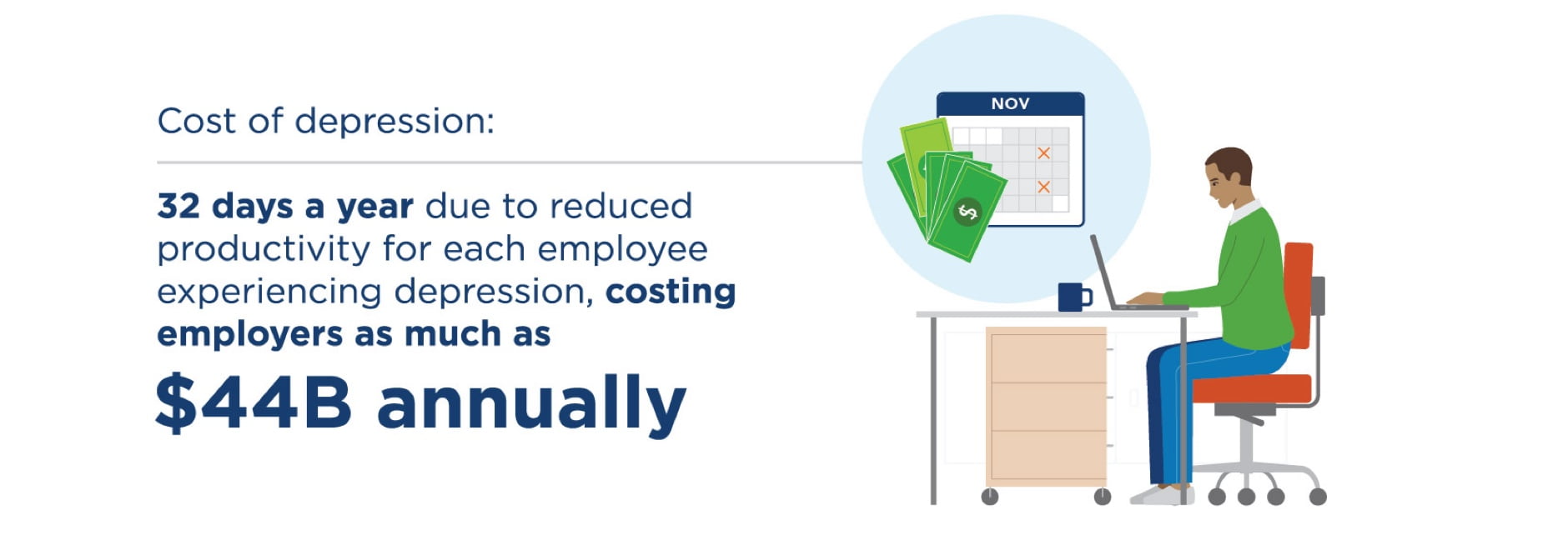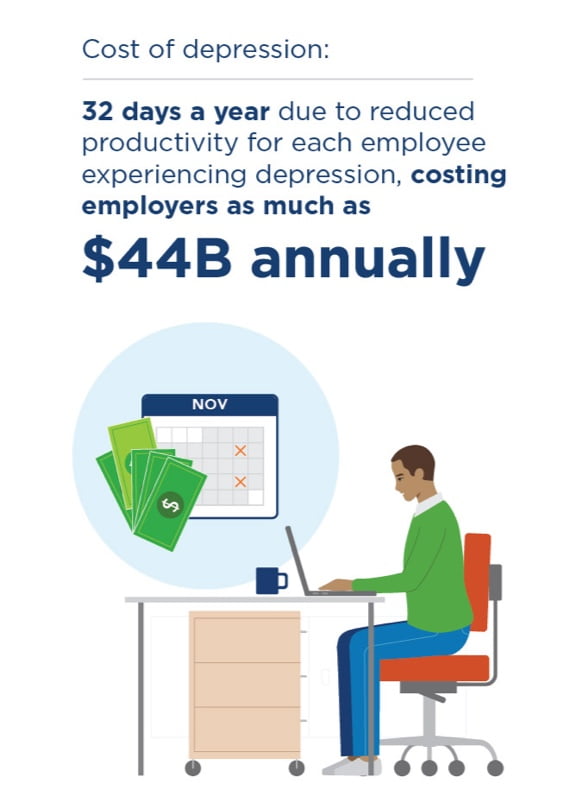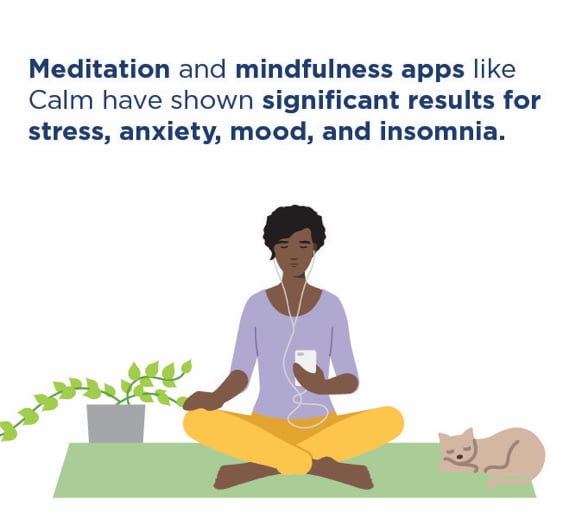From increased work hours or workload to additional demands at home, the COVID-19 pandemic added new stressors to nearly every area of daily life. With these persistent stressors, your employees may need more support with their mental health. Mobile apps, while not a replacement for mental health services, are one way to extend self-care support and can be a great complement to your corporate wellness programs. But some apps are more effective than others. Read on for tips on how to find the right mental health app for your workforce.

How to pick a mental health app for your workforce wellness program


Growing demand for mental health apps
As people cope with the continued stress and anxiety from current events, the demand for mental health resources has climbed. From 2019 to 2021, adults who received mental health treatment in the previous 12 months increased 12.5%.1 Also, untreated depression costs American companies billions each year. The cost of depression is 32 days a year due to reduced productivity for each employee experiencing depression, costing employers as much as $44 billion annually.2
Mobile apps have become popular for people seeking virtual mental health services. App makers are seeing a significant spike in mental health app downloads and usage. For example, app company Livongo saw a 140% increase in usage of their mental health app in March 2020 compared to September 2019.3 Mobile apps aren’t a replacement for clinical therapy, but they do offer convenience, privacy, comfort, and access to self-care whenever someone needs it.


Why you should add apps to your wellness program
This interest in mental health services — and apps — also extends to your workforce. Self-care apps with a focus on mental health may be a worthwhile addition to your larger workforce health initiatives. According to The Conference Board, 88% of organizations offer programs that support emotional well-being (e.g., mental health resources, Employee Assistance Programs), but only 53% include virtual therapeutic platforms, meditation, or relaxation subscriptions.4 By offering apps, employers can help strengthen the mental health support they provide to employees.
A guide to picking the best mental health app
Choosing an app for your company’s corporate wellness program can be overwhelming. There are apps to help with stress, anxiety, insomnia, depression, addiction, mood, post-traumatic stress disorder, and the list goes on. With so many self-care apps on the market, how do you know which one is safe, effective, and worth the investment?
To help get to the bottom of this, our team of Kaiser Permanente health researchers has been vetting mental health and wellness apps for years. We’ve been reviewing scientific research, talking with app companies, studying consumer behavior, and working with therapists to see how these tools can be used in practice.
Based on our team’s findings, here are 5 tips to help you choose the mental health app that’s best for your workforce
wellness program.


1. Narrow your search to these 2 types of apps
The best place to start is with meditation and mindfulness and cognitive behavioral therapy apps, since they typically have the evidence and science to back up their claims.
Meditation and mindfulness apps like Calm have shown significant results for stress, anxiety, mood, and insomnia. In a recent study of college students, participants who used the Calm app to meditate for at least 10 minutes per day over 8 weeks reported feeling less stressed, plus they experienced an improvement in mindfulness and self-compassion.5
Cognitive behavioral therapy apps like myStrength are modeled after talk therapy. And so far, the research shows that these digital experiences can be just as useful and effective as in-person talk therapy. 74% of myStrength users experienced improvements in depression scores, and myStrength has been shown to be 82% as effective as face-to-face therapy.6
2. Test it out before you buy
Pick an app with a seamless user experience. If the app isn’t easy to figure out, you won’t use it, and neither will your employees. And it will be a waste of your workforce wellness dollars.
Request a free trial for a small group of decision-makers at your organization. Then ask your test group: Was it easy to use? Could you quickly find what you were looking for? Did you find the activities engaging? Did you lean on the app during a stressful time?

3. Pick an app that won’t share your employees’ data
Personal data is a hot commodity in the tech world. And many app companies, especially those behind the free ones, make money by selling user data. Only work with companies that protect your employees’ personal health information.
Unlike a consumer, when you’re a company setting up a business account with an app, you can set data and privacy stipulations in your contract. And when you roll out the app to your staff, let them know their privacy and data is protected so they feel safe using it.
4. Weigh pros and cons of self-guided vs. coaching apps
A self-guided app is one where the user engages with the content, tracks their progress, and the entire experience is done on their own. A guided app, on the other hand, has a trained professional that leads or helps the user through the online experience. The user can ask them what to do next and talk back and forth about what’s working for them.
The price point varies between the styles. Guided versions typically cost more. However, during our review of numerous studies, we found that apps with a coach or guide typically help reduce depression more significantly than self-guided apps.7
5. Go to nonprofit and mental health groups for reviews
Our team’s favorite is Psyberguide. external page. They’re a nonprofit, affiliated with the University of California Irvine’s Department of Psychological Science. They do a nice job of reviewing mental health apps for credibility, user experience, and transparency in hopes of helping consumers and mental health professionals make informed decisions about digital mental health.
Another trusted entity is the American Psychiatric Association. They developed a rating system. external page to help mental health professionals evaluate apps based on security, evidence, ease of use, and other functions.

Apps are a great complement to your wellness program
It’s best to go with an app that’s evidence-based and tested in the marketplace, transparent about privacy, easy to use, and in alignment with your workforce wellness initiatives. And while these apps aren’t a total replacement for in-person therapy, they’re a way to expand access and help your employees achieve their short and long-term mental health and wellness goals.
About our expert

Trina Histon is a Senior Principal Consultant in Prevention, Wellness, and Digital Health at Kaiser Permanente’s Care Management Institute. She’s currently co-lead on Kaiser Permanente’s enterprisewide effort to deploy an ecosystem of digital mental health tools to support emotional wellness for members. With a PhD in health psychology from University College Cork, Ireland, Trina has built her career around translating scientific evidence on prevention, well-being, behavior change, and emotional health into health care practice.
Resources you may find helpful



- 1
Emily P. Terlizzi, MPH, and Jeannine S. Schiller, MPH. “Mental Health Treatment Among Adults Aged 18–44: United States, 2019–2021,” NCHS Data Brief No. 444, September 2022
- 2
Allison Williams, et al., “Can Online Tools Help Employees Build Resilience?” Harvard Business Review, April 24, 2019.
- 3
Robbins, Rebecca, “Coronavirus Pandemic Sets Up Potential Breakout Moment for Virtual Mental Health Care,” STAT, April 13, 2020.
- 4
“Mental Health Support Increasing, But Workers Still Struggle,” The Conference Board, conference-board.org, May 9, 2022.
- 5
Huberty, Jennifer, et al, “Efficacy of the Mindfulness Meditation Mobile App ‘Calm’ to Reduce Stress Among College Students: Randomized
Controlled Trial,” JMIR mHealth and uHealth, vol. 7, June 25, 2019. - 6
Fred Pennic, “Livongo Acquires Digital Behavioral Health Solution myStrength,” HIT Consultant, January 30, 2019; Krista Schladweiler, et al., “Real-World Outcomes Associated with a Digital Self-Care Behavioral Health Platform,” Annals of Clinical Research and Trials, October 31, 2017.
- 7
Internal Kaiser Permanente research study.
Kaiser Permanente health plans around the country: Kaiser Foundation Health Plan, Inc., in Northern and Southern California and Hawaii • Kaiser Foundation Health Plan of Colorado • Kaiser Foundation Health Plan of Georgia, Inc., Nine Piedmont Center, 3495 Piedmont Road NE, Atlanta, GA 30305 • Kaiser Foundation Health Plan of the Mid-Atlantic States, Inc., in Maryland, Virginia, and Washington, D.C., 2101 E. Jefferson St., Rockville, MD 20852 • Kaiser Foundation Health Plan of the Northwest, 500 NE Multnomah St., Suite 100, Portland, OR 97232 • Kaiser Foundation Health Plan of Washington or Kaiser Foundation Health Plan of Washington Options, Inc., 1300 SW 27th St., Renton, WA 98057
Congratulations! You have successfully saved this item.
To access your Saved items any time, open the "Saved Items" folder in the top right corner of the page.
It seems that you do not have cookies enabled. Please enable cookies to make use of all of our site's functionality.
You haven't collected any items yet.
- Save Content
Click the "Save" icon next to the content you want to revisit later.
- Access Your Saved Items
Click on the "Saved Items" link at the top of the page or use the URL we create for you.
Be sure to copy and paste the URL we create for you before you leave the site.
1-5 of 14
Your Link
After leave the site, your saved items will be saved for you at this URL:
https://business.kaiserpermanente.org/saved-items?user=Share your list
Show Disclaimer +


